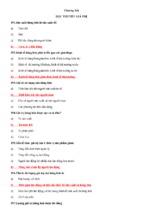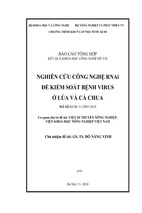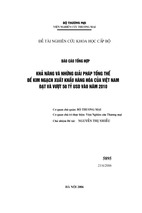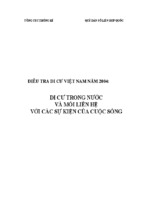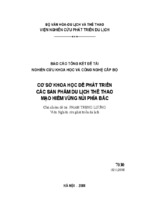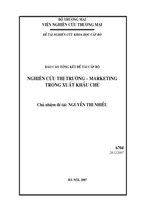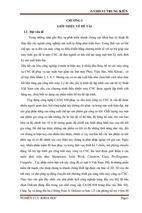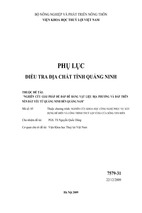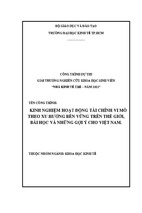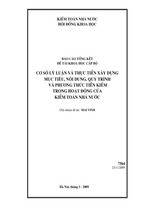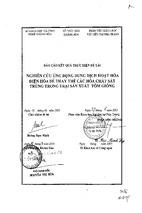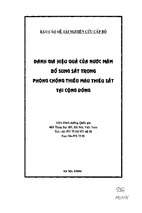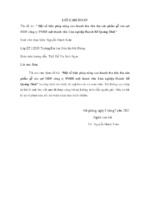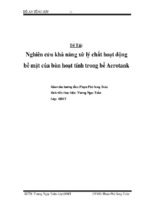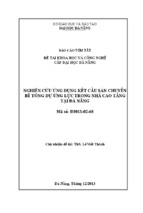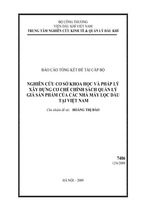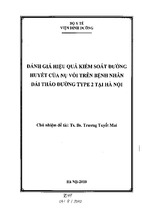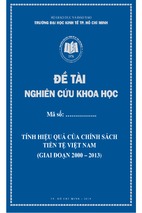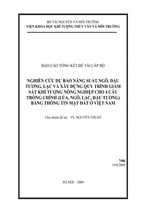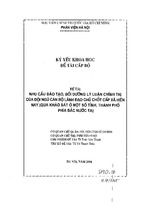_______________________________________________________________
TERM PAPER
REPORT
Topic: TRADE BARRIERS IN VIETNAM
Course: International Economic
Instructor: Dr. Nguyen Binh Duong
Name student: Nguyen Thi Hoang Yen
Contents
Preface
I-The concept and classification trade barriers.
1. Concept
2. Classification of trade barriers
a) Tariff barriers
b) Non-tariff barriers
II-The purpose of the trade barriers.
1. The establishment trade barriers
2. Purpose of trade barriers
a) The purpose of the tariff barriers.
b) The purpose of the Non-tariff barriers.
3. Advantages and disadvantages of trade barriers.
a)Advantages
b)Disadvantages
III - Results and solutions trade barriers.
1. The result of the application of trade barriers for the economy
2. Solutions the remaining matter in the application of the tariff barriers.
Conclusion
Preface
Over the way more than 5 years (from 2007 to 2013) engaged in The World Trade
Organization (WTO), Vietnam has great progress marked the development of the economy.
Particularly in international trade, Vietnam has a certain position in the international
marketplace. The wider goal of integration is global economy. Economic Globalization is
through free-trade activities channel. It is seen as a giant bridge connecting trade between
countries. However, Vietnam still exist difficulties that are barriers to trade in the integration
process. The question arises that how to overcome these barriers. The barriers are one of the
drawbacks to economy in the process free trade with foreign countries. Vietnam economy to
sustainable development and stability must necessarily overcome these difficulties. Vietnam
economy to sustainable development and stability must necessarily overcome these
difficulties. Trades barriers are always matter of urgency and still have many issues
unresolved. So, I want to present my opinion on this issue in this essay.
1. The objective of the study
The goal of the essay is to study the current status of trade barriers and solutions to solve this
problem.
2. For research subjects
- Object: trade barriers Vietnam's economy integration
- Scope of the Study: Trade Barriers in Vietnam's economic integration
3. Research Methodology
The essay research methods used meta-analysis, comparing research methods set in
international economic integration environmental.
4. The structure of the essay.
I- Concept and classification of trade barriers
II- The purpose of trade barriers.
III - Results and solutions trade barriers.
TRADE BARRIERS IN VIETNAM
I- The concept and classification trade barriers.
1. Concept.
International trade is the exchange of goods and services between the countries in the
world to obtain economic benefits. Thus, trade barriers can be easily understood the
government making measures which are barriers for international trade to prevent foreign
goods entering the domestic market. Trade barriers of each country are different and are
governed by the laws of each country and international law.
2. Classification of trade barriers.
There are many types of trade barriers. We can be divided into two main groups of
trade barriers by the WTO. They are tariff barriers and non-tariff barriers.
a) Tariff Barriers
Tax barriers are commonly used in many countries. It is also kind of barriers are used
primarily in Vietnam for imported goods. There are three types of taxes ad-valorem tariff,
non ad-valorem and specific tariffs.
Ad-valorem tariff is tax as a percentage of the transaction value of imported goods. This
type of tariff is applied commonly applied today.
Non ad-valorem includes three types. Absolute taxes are determined by a fixed amount per
unit of imported goods. This tax is usually applied to agriculture products. Absolute tax
alternative is the option tax regulations applied ad-valorem tariff or absolute tax. Compound
tax is a combination of ad-valorem tariff and absolute tax.
Tariffs specific include many types such as quotas, the countervailing duty, antidumping tax, additional tax. Quota is measures management is applied for imported goods.
Goods of quotas are applied tax rate lower than that of without quotas. Countervailing duties
are special taxes are levied on imported products to compensate for the government subsidies
for the production and export of that product. Anti-dumping tax is applied to prevent and deal
with the import of goods that are dumped into the domestic market creating unfair
competition.
Each country applies different tax policies for the same commodity. In addition, there
is some kind of tax to be applied in international trade now. Most Favored Nation (MFN)
tariff is which the member countries of the WTO apply to the other member countries or the
country together base on bilateral agreement on preferential tariff. MFN tariff are often lower
than normal tax. Good Storage Practices tariff (GSP) is a preferential for some imported
goods from developing countries to developed countries is the GSP. GSP is lower MFN. Tax
which applies to the free trade area is the lowest taxes or may be zero for some goods. This
tax has preferential is very high.
Based on the advantages of each country's production and economic potentials, each
type of tax will be applied to different kinds and levels for each commodity. So each
country's tariff for the same commodity will be different. That leads to the same commodity
is advantaged for this country but would be disadvantage for other countries. The situation
has created barriers to trade between countries.
b)Non-tariff barriers
If trade barriers and tariffs are specified and can be clearly identify then non-tariff
barriers to more complex in nature. Non-tariff barriers that the state is not in use and use tariff
administrative measures or technical measures to discriminate against the entry of foreign
goods into the domestic market. When tariff barriers between countries are removed, other
forms of trade barriers, such as the technical nature of the technical regulations, sanitary,
environmental, product quality standards appeared more and more. The non-tariff barriers
were considered strict and obstruct bigger tariff barriers to trade between countries. Technical
barriers in international trade (TBT) are defined barrier quality management system,
environment for businesses entering the export market of another country. The Sanitary and
Phytosanitary measures (SPS) including all laws, decrees, regulations, requirements and
procedures, processes and production methods, testing, inspection and quarantine process.
This type of barrier is increasingly stringent levels higher and higher. Regulations on
intellectual property as defined in origin of goods. The regulations on environmental
protection, including environmental regulations outside territorial border agreement or
international convention, the direct regulation of the environment in the national territory.
The major regulations include regulations conditions of production, testing or circulating and
distribution of the product is defined in the WTO agreements. Export quotas, import quotas
quantity or value permitted for export or import in a certain period. The prohibitions include a
ban on all measures, partial embargo, banning import or export of some goods. Only business
be assigned export or import. Regulations on investment related to trade which regulations
minimum ratio of capital contribution or the maximum for the commodity area. Regulations
on trade in services as specified in a company, a branch office of the foreign and domestic.
Cultural barriers are the differences in perception, the differences in language, customs
barriers and are extremely difficult to remove.
It is the kind of barrier most popular used today. What is cause of the formation of
trade barriers and how trade barriers are used for purposes?
II-The purpose of the trade barriers.
1. The establishment trade barriers
Trade barriers have a long-term formation process. Initially, when supply not enough
to meet demand of commodity, international trade happening free. The trade barriers are
almost none. However, as the world economy grows, the result is that many countries have
excess supply of commodity. In contrast to this case, many countries lack a supply of goods.
As a consequence several countries have surplus commodity into other countries' markets,
but international trade free in a general look that only benefit a certain group of people.
Further, it can be negatively impact the economy of a country. Since then, trade barriers are
formed.
2. Purpose of trade barriers
In theory, free trade and bilateral trade agreements are formed between countries
helps both parties benefit. But it just right in conditions of both countries have the same
economic potential, it demand Rest of commodity that can be meet and exchange rates
comparable to other countries. Actually, the countries have ability to free trade is not always
the highest benefit. Especially free trade occurs between countries different specialization.
a) The purpose of tariff barriers.
The purpose of the tariff is to increase revenue for the government budget. Moreover,
it has role protect domestic manufacturers. In the long run, trade barriers are nature's
development strategy for the country's economy. In addition, it also aims to create
competition for your country. Applied tariff barriers are also one of the factors that motivated
to achieve political objectives.
b) The purpose of the non-tariff barriers.
The same as purposes of non-tariff measures, trade barriers and non-tariff is applied to
protect domestic production. Important purpose of this barrier is to protect the environment
and scarce resources in the country, to protect the interests and health of consumers. On a
wider scope, it also measures to protect national security.
Both group’s tariff trade barriers and non-tariff barriers to trade are generally the main
purpose is to create more supply and demand balance in the balance of import and export
trade between nations. Each of these methods has advantages and disadvantages.
3. Advantages and disadvantages of trade barriers
a)Advantages
Advantages of trade tariff barriers are clear, transparent, and predictable and generate
revenue for the government budget. Each commodity is defined with specific tax rates based
on the commitments and tariff schedule of each country listed.
Non-tariff barriers to trade are focused on the ability to import restrictions. The
advantage of this group of barriers is likely to apply to commodities quickly import
restrictions immediately and indirect effects to the protection of domestic manufacturers. On
the other hand, non-tariff measures are used for many purposes. For example, regulations on
quality control to ensure the health of the consumers and impact protection to domestic
products.
b) Disadvantages
Tariff measures are the most popular used but it does not make quickly protection.
This might affect domestic production. For some items, such as cars, motorcycles imports
still taxed too high. In addition, non-tariff barriers to trade are also disadvantages as easily
distort the market signals. The non-tariff measures difficult to predict and not to bring
revenue to the government but to incur significant costs.
Both groups of barriers have advantages and disadvantages, they are often used
simultaneously. For each commodity should be applied flexibly to gain maximum benefit
from the use of trade barriers.
III - Results and solutions trade barriers.
1. The result of the application of trade barriers for the economy
Vietnam to join in international economy is a big step forward. The benefits of free
trade gives the economy of Vietnam is about huge benefits but we should not abuse. The
economic development of country need compromise trade between our countries and foreign
countries.
Thus, trade barriers can not be removed completely. It was self-defense weapon for
the economy of each country. It helps us to be proactive in the regulation of supply and
demand and prevent the takeover market in the country by foreigners. In terms its position in
the world, Vietnam is still a small country and the economy of Vietnam is growing.
Comparison of internal resources and the ability of Vietnam to be competitive with large
countries such as China or the United States is still a very far distance. The downside of trade
barriers applied in Vietnam is not really identified with the international legal system. This is
a major obstacle can not be overcome quickly. Those are not good consequence of using
trade barriers.
We can see Table 1 - Average tariff commitments by industry group. It is comparison
between before and after Vietnam take in WTO. After Vietnam become a member of WTO,
tax of some commodities decrease.
1
2
3
4
5
6
7
8
9
Table 1 - Average tariff commitments by industry group
Tariff at the
time of
Tariff reduction
Group items
commitment
commitment
Agricultural
25.2
21
Fish and fish products
29.1
18
Petroleum
36.8
36.6
Wood, paper
14.6
10.5
Textiles
13.7
13.7
Leather, rubber
19.1
14.6
Metals
14.8
11.4
Chemicals
11.1
6.9
Transport equipment
46.9
37.4
10 Machinery and mechanical appliances
9.2
7.3
11 Machinery and electrical equipment
13.9
9.5
12 minerals
13 Other manufactured goods
16.1
12.9
14.1
10.2
2. Solutions the remaining matter in the application of the tariff barriers.
Trade barriers are a very complex system. It has many problems not really reasonable.
So, should we use trade barriers during the economic integration? Elimination of
unreasonable trade barriers is not easy. If we do not overcome this barrier, Vietnam hardly
get high position in the international arena. Elimination of the barriers needs to cooperation
and mutual assistance between the government and domestic the producers.
Regarding the government need assistance the domestic businesses have the best
conditions to improve the quality of goods and products to be able to competitive with
imported products. Moreover, the government has policies for
helped to support the
producers in domestic sales to achieve maximum benefit, there are incentives to subsidy
domestic businesses.
Regarding business need to be responsible for cooperation and compliance with the
standard manufacturing process quality through accreditation to be able to stand on free
market in a free trade environment.
Besides the elimination of trade barriers such as unreasonable tariffs or reducing
tariff, and we still need to keep building barriers needed to ensure the economy is not deficit
balance of trade with countries in free trade. The construction reasonable barriers will help us
selected objects who should be exchanged in free trade. It will bring to maximize the gains
from free trade to the country.
Conclusion
Vietnam is a developing country and is potential market exploitation. Therefore,
penetration of foreign goods into the domestic market is unavoidable. Additionally, trade
exchange is also a factor to help us gain experience to learn and apply so that achieve growth
in the economy. Trade barriers are varied and always good and bad exist in parallel.
However, we need to know the correct selection and use of the purposes of each barrier, trade
barriers used properly will be a factor promoting strong economy.
References
1. Robert J.Carbaugh ,13th.International Economics.
2. William H.Shaw and Vincent Barry, 2009. Moral Issues in Business. Cengage
Learning
3. Roger A.Arnold,2008,Macroeconomics. Cengage Learning.
4. Mai Phuong, 2013.Tháo gỡ rào cản cho xuất nhập khẩu. [online] Available at: <
http://www.thuongmai.vn/xuat-nhap-khau/xuat-khau-viet-nam/115849-thao-go-raocan-cho-hang-xuat-khau.html >[Accessed 7 May 2013].
5. Phuong Anh, 2013.Việt Nam dẫn đầu danh sách các thị trường sơ khai hấp dẫn nhất
thế giới. [online] Available at: < http://www.thuongmai.vn/thi-truong/thi-truong-vietnam/113823-viet-nam-dan-dau-danh-sach-cac-thi-truong-so-khai-hap-dan-nhat-thegioi.html>[Accessed 10 May 2013]
6. Baomoi, 2013.Doanh nghiệp Việt và những rào cản thương mại [online] Available at:
< http://www.baomoi.com/Doanh-nghiep-Viet-va-nhung-rao-can-thuongmai/45/4456527.epi>[Accessed 12 May 2013]
7. Ha Hoa Tan,2013,Vươn lên nắm bắt cơ hội từ các hiệp định thương mại.[online] Available
at: < http://www.thuongmai.vn/thuong-mai/thuong-mai-viet-nam/115722-vuon-lennam-bat-co-hoi-tu-cac-hiep-dinh-thuong-mai.html>[Accessed 10 May 2013].
- Xem thêm -

